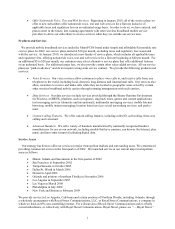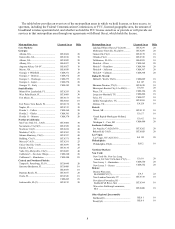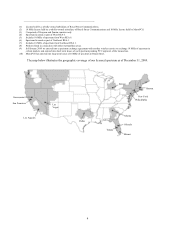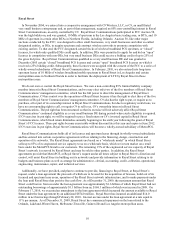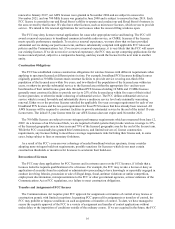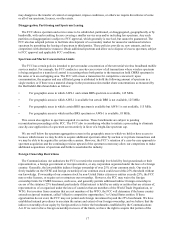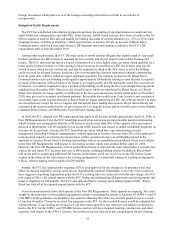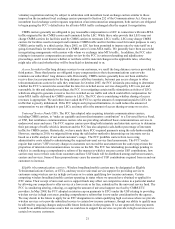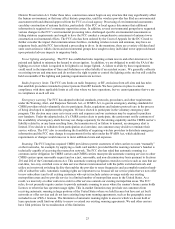Metro PCS 2009 Annual Report Download - page 27
Download and view the complete annual report
Please find page 27 of the 2009 Metro PCS annual report below. You can navigate through the pages in the report by either clicking on the pages listed below, or by using the keyword search tool below to find specific information within the annual report.15
AWS-1 spectrum. The FCC has assigned 90 MHz of spectrum to be used for advanced wireless services, or AWS.
The FCC divided the 90 MHz of spectrum into two 10 MHz and one 20 MHz paired blocks assigned on a regional
economic area grouping, or REAG, basis; one 10 MHz and one 20 MHz paired blocks each assigned on an
economic area, or EA, basis; and a 20 MHz paired block assigned on a Cellular Marketing Area, or CMA, basis. The
CMAs generally correspond to MSAs and RSAs. Under the AWS band plan, the United States is divided into 176
EAs, 12 REAGs, and 734 CMAs. The EAs are geographic areas defined by the Regional Economic Analysis
Division of the Bureau of Economic Analysis, U.S. Department of Commerce, as supplemented by the FCC.
REAGs are collections of EAs.
700 MHz spectrum. The FCC has assigned 62 MHz of spectrum in the 700 MHz band. The FCC divided the 62
MHz of spectrum into two 12 MHz paired blocks and one 6 MHz unpaired block licensed on a CMA or EA basis;
one 22 MHz paired block licensed on a REAG basis, and one 10 MHz paired block, or D Block, assigned on a
nationwide basis to be used as part of a private/public safety partnership. Holders of the 22 MHz licenses, most of
which are held by one of our competitors, must provide a network platform that is generally open to third-party
wireless devices and applications, or an Open Network Platform, by allowing consumers to use the handset of their
choice and to download and use the applications of their choice, subject to certain network management conditions
that are intended to allow the licensee to protect the network from harm. As originally allocated, the D Block
licensee was required to enter into a public/private partnership with a designated public safety broadband licensee
for the purpose of constructing and operating a nationwide interoperable broadband network for public safety on a
nationwide public safety license and to provide public safety with priority access during emergencies to the D Block
owned by the licensee. The D Block remained unpurchased at auction, and the FCC currently is considering
revisions to the auction and service rules that will apply to this license.
BRS spectrum. In 2004, the FCC ordered that the 2496-2690 MHz band, or the 2.5 GHz band, be reconfigured
over a period of time into upper and lower-band segments for low-power operations, with a mid-band segment for
high-power operations. This spectrum is allocated and licensed in the United States and its possessions and
territories in 493 BTAs. The Commission concluded in 2008 that 55.5 MHz of the broadband radio service, or BRS,
spectrum holdings in the 2.5 GHz band will be included in the Commission’s product market for mobile
telephony/broadband services, and taken into consideration when the Commission is assessing the competitive
impact of broadband wireless merger and acquisition transactions.
Future allocations. The FCC has certain broadband wireless spectrum allocation proceedings in process. For
example, the FCC is considering service rules for an additional 20 MHz of paired AWS spectrum, or AWS-2, in the
1915-1920 MHz, 1995-2000 MHz, 2020-2025 MHz and 2175-2180 MHz bands, as well as 20 MHz of unpaired
AWS spectrum, or AWS-3, in the 2155-2175 MHz band. Both AWS-2 and AWS-3 have been allocated for
advanced fixed and mobile services, including AWS. As noted above, the FCC also is seeking further comment on
service rules for the 700 MHz D Block. The FCC and interested parties have proposed that these blocks of spectrum
be subject to various conditions, configurations and terms and conditions. Recently, the FCC has initiated a series of
proceedings designed to identify additional spectrum that can be reformed, reassigned, or reallocated to meet a
perceived need for an additional significant amount of spectrum for wireless broadband mobile services. There is no
certainty whether such additional spectrum will be made available, the amount of spectrum which might ultimately
be made available, the timing of the auction of any such spectrum, the process for clearing incumbent users, the
likely configuration of, and conditions that might apply to, any such additional spectrum, or the usability of any of
this spectrum for wireless services competitive with our services or by us. In addition, Congress may pass
legislation or the federal government may undertake actions or proceedings in the future to reallocate spectrum from
government use to private commercial use for wireless services or to change the rules relating to already licensed
spectrum, which may allow new or existing licensees to provide services comparable to the services we provide.
License term
The broadband PCS licenses held by us and by Royal Street have an initial term of ten years, our AWS licenses
have an initial license term of fifteen years, and our 700 MHz license has an initial term of ten years from June 13,
2009. If we fail to meet an initial construction benchmark in June of 2013 for our 700 MHz license, the license term
will be shortened to June of 2017, and we may be subject to fines and forfeitures and/or a reduction of our licensed
service area. In addition, if we fail to meet the build out requirements by the end of the license term for our 700
MHz license, we will lose our authority to serve any unserved area within our 700 MHz license area and could be
subject to fines and forfeitures, including a revocation of our 700 MHz license. Subject to applicable conditions, all
of our and Royal Street’s licenses may be renewed at the end of their terms. Our initial broadband PCS licenses for
San Francisco, Sacramento, Miami and Atlanta were granted in 1997, were renewed in 2007 and are subject to




